-- 作者:tennis123
-- 时间:2009/4/23 13:41:37
-- 如何选拍???(中英文版)
If you’re like most Tennis Warehouse customers, you already have an idea of the type of racquet you’re seeking. You want to upgrade from your current racquet - maybe you’re seeking more power, more control, more comfort... or a little of all three. Whatever your reason(s) for purchasing a new racquet, you have some basis on which to make your decision.
Then again, you may not have a clue as to which racquet is best for you and are simply motivated by a review you read. Add to the confusion the shear amount of racquets available and choosing the right racquet becomes pretty daunting! To make this process a little easier, here’s a primer on racquet characteristics and how they affect performance. We also suggest you read our racquet reviews where you’ll find detailed information from real tennis players on how a specific racquet performs on-court. Our Racquet Technologies section includes explanations and illustrations of racquet technologies and materials, such as nCode, Hot Melt, Liquidmetal, and F.I.R.E., to name a few. Finally, our General Racquet & String Terms provide definitions of terms that are used throughout our website to describe racquet and string performance.
Today, there are 3 major racquet categories, with several subcategories. They are:
Category 1: Power or Game Improvement Racquets
This is the term used by racquet manufacturers for power-oriented racquets. In most cases, these racquet models feature oversize to super-oversize heads (107-135 square inches), are lightweight (8-9.5 ounces), longer (27-29 inches) stiffer and are balanced head-heavy (or evenly balanced) to retain enough weight in the hitting zone. Designed for players with shorter, slower swings and who want more power from the racquet. Here are some of the top game improvement racquets:
Select Game Improvement Racquets
Babolat VS NCT Power Racquets
Head Flexpoint 10 Racquets
Prince O3 Blue Racquets
Prince O3 Silver Racquets
Wilson n1 nCode Racquets
Wilson n3 nCode Racquets
Yonex Nano Speed RQ 8 Racquets
Category 2: ‘Tweener Racquets
There are several models that offer a blend of features from game improvement and player’s racquets. They are often light-er (9.5-11 ounces), balanced anywhere from slightly head-light to slightly head-heavy, have midplus (95-102 square inches) heads and are usually extended length (27.5-28 inches). These racquet models offer low-medium to medium-high power and are most appealing to intermediate-advanced players, seeking enhanced maneuverability. Here are some of the top 'tweener racquets:
Select Tweener Racquets
Babolat AeroPro Drive Racquets
Babolat Pure Drive Roddick Plus Racquets
Babolat Pure Drive Team Plus Racquets
Dunlop M-Fil 500 Racquets
Head Flexpoint 4 Racquets
Prince O3 Hybrid Hornet Racquets
Prince O3 Hybrid Shark Racquets
Prince O3 Red Racquets
Prince O3 White Racquets
Prince Shark Racquets
Volkl Becker BB 10 Racquets
Volkl DNX V1 Racquets
Wilson n5 nCode Racquets
Wilson nCode nTour Racquets
Yonex Nano Speed RQ 5 Racquets
Yonex RDX 300 Racquets
Category 3: Control or Player’s Racquets
Denotes racquets that would be used by professional and high-level club and college team players. These models are typically heavier in weight (11.5-13+ ounces), have smaller heads (85-98), thinner, more flexible beams and are balanced head light to retain maneuverability. The result is a low-power racquet, designed for players who provide their own power and prefer a racquet that offers more control. Can be standard or extended length. Here are some of top player's racquets:
Select Player's Racquets
Babolat AeroPro Control Racquets
Babolat Pure Control Team Standard Racquets
Dunlop M-Fil 200 Racquets
Fischer M Speed Pro Number One Racquets
Head Flexpoint Prestige Racquets
Head Flexpoint Radical Tour Racquets
Head Liquidmetal Prestige Racquets
Prince O3 Tour Racquets
Prince Tour Diablo Racquets
ProKennex Core1 No. 6 Racquets
ProKennex Heritage Type C Racquets
ProKennex Heritage Type C Redondo Racquets
Tecnifibre TFight 325 Racquets
Volkl Tour 10 MP Generation II Racquets
Volkl Tour 10 V-Engine Mid Racquets
Wilson nSix-One 95 nCode Racquets
Wilson nSix-One Tour 90 nCode Racquets
Yonex RDX 500 Racquets
When making a racquet choice,
you’ll need to consider the following features:
Head Size
Power is directly related to head size - a larger head will provide more power than a smaller head, all other things being equal. A larger head also offers a larger hitting area and sweetspot, providing more forgiveness on off-center hits. Today’s racquets are offered in head sizes ranging from 85 to 135 square inches, with the most common being 95-110. These head sizes offer a compromise between power and control for many players. Generally speaking, a smaller racquet head appeals to more accomplished players seeking more control, while larger racquets appeal to beginning and intermediate players seeking more power and a larger sweetspot.
Length
Racquets are available in lengths ranging from 27-29 inches, the legal limit for tournament play. Standard racquets are 27 inches long. A longer racquet provides more reach on groundstrokes, added leverage on serves and slightly more power overall than standard length racquets, all other things being equal. For most players, switching from a standard length racquet to one that is 1/2 -1 inch longer doesn’t normally present much of a problem. Most (but not all) longer racquets are lighter than their standard-length counterparts to keep them maneuverable. As racquet length increases, so does dynamic swingweight. Simply lengthening a 27 inch racquet without reducing weight would result in a very unwieldy “club”.
Weight & Balance
These two characteristics most influence how a racquet feels when you pick it up and when you swing it on the tennis court. Some basic concepts - a heavy racquet is more powerful, more stable and transmits less shock than a lighter racquet (all other things being equal). A lighter racquet is more maneuverable and thus, a player is able to swing it faster. If this is true, won’t a lighter racquet that is swung fast generate the same power as a heavier racquet that’s swung more slowly? This question has been hotly debated ever since Wilson introduced their Hammer racquets back in 1990. Until then, racquet weights averaged 12-13 ounces and were balanced head light (or handle heavy). Wilson’s Hammer “technology” reduced overall racquet weight (10-11 ounces) but distributed more mass in the head, resulting in a head-heavy balance. The idea was to improve maneuverability without sacrificing power by keeping weight in the racquet’s hitting zone. Since then, racquet weights have steadily dropped and now we have sub-10 ounce offerings from most manufacturers. Is lighter better? Not necessarily. Well then, which racquet weight is best for you? What about racquet balance? Is head-light, head-heavy or even balance best? In order to answer this question, you need a point of reference. How heavy is your current racquet? Is it head light or head-heavy? How much? If you don’t know, you can e-mail us at info@tennis-warehouse.com and we’ll send you the manufacturer’s specifications, if available.
Next, do you want a lighter, heavier or similarly weighted racquet? Head-light, head-heavy or evenly balanced? Chances are you don’t know what you want until you play with a racquet. If this isn’t feasible, here are some guidelines on the advantages and disadvantages of different weights and balances.
Heavier, head-light racquets- preferred by most professional players, these racquets are often referred to as being “traditionally weighted and balanced” racquets. They typically weigh 11-13 ounces and are balanced 1/2 to 1-1/2 inches head light in order to retain maneuverability. In most cases, these racquets are also referred to as “player’s” racquets because they are generally more control-oriented and designed for players who provide their own power.
Lightweight, head-heavy racquets - several years ago, Wilson discovered it was possible to make a racquet more maneuverable without reducing weight in the head. By removing weight in the handle, the racquet was lighter overall, while still retaining mass in the upper hoop, where ball contact occurs. This was the concept behind their Hammer and Sledge Hammer designs. Several other racquet manufacturers have subsequently introduced lightweight, head-heavy (and evenly balanced) racquets. The advantages of this racquet type are increased maneuverability without sacrificing power, especially on groundstrokes. The disadvantages are less clear - some “experts” argue that reducing weight increases the amount of shock transferred to the wrist, elbow and shoulder. Some players who have switched from traditionally weighted and balanced racquets to lightweight, head-heavy models claim the racquets don’t feel “solid”. Clearly, you can’t get something for nothing. Reducing racquet weight will alter its feel - for better or for worse. Keep in mind, you can always add weight to a racquet if it’s too light. Reducing racquet weight, however, is almost impossible.
Frame Stiffness
The amount a frame deflects during ball contact directly affects its power potential. A stiffer racquet bends less, thus depleting less energy from the ball. A flexible racquet bends more, resulting in more energy loss. A common myth among players is that a flexible racquet, that bends back more, returns more power to the ball due to a catapult-effect. The ball remains on the strings for 3-5 milliseconds, much shorter than it takes a frame to recover. Consequently, a racquet frame doesn’t “return” energy to the ball, it absorbs energy - either more or less, depending on stiffness. Stiffer racquets don’t deflect as much on impact, resulting in less power drain than a flexible racquet.
Frame stiffness doesn’t only affect power though. Control and comfort are also at stake. Generally speaking, a racquet that offers more power provides less control. However, this is largely dependent on player type and ability. An advanced player may prefer a flexible racquet because he or she has a long, fast swing and provides plenty of power. A stiff racquet might be too powerful for this player, resulting in too many balls landing long. A beginning or intermediate player though, may find a stiffer racquet that doesn’t deflect as much on impact, provides better control. This may also apply to a more advanced player with short, compact strokes. To a certain point, stiffer racquets are generally less comfortable than more flexible racquets. A very stiff frame will transmit more impact shock to the wrist, elbow and shoulder than a medium stiff frame. Comfort is difficult to measure - each player has a different perception of what feels comfortable. However, players with arm and/or shoulder problems will generally benefit more from a flexible to medium-stiff frame and should likely avoid stiff or very stiff frames. A lesser known effect of frame stiffness is the amount of spin that can be generated. Generally speaking, stiffer racquets provide less spin than flexible racquets because the ball leaves the stringbed more quickly.
String Pattern
Often overlooked by many recreational players, string pattern density influences many aspects of a racquet’s overall performance and feel. When we discuss string pattern density, we refer to open and dense (or closed).
An open string pattern will deflect more on impact than a denser pattern, providing greater ball rebound. Strung at the same tension (in similar racquets) an open string pattern won’t feel as “tight” as a dense string pattern. Open string patterns also allow for more spin potential, as the ball can embed itself into the strings more, due to their wider spacing. Players seeking more spin will benefit from a more open string pattern. The price one may pay for this, though, is reduced string durability. Open string patterns allow the strings to move more freely, increasing abrasion which causes string breakage.
A denser string pattern won’t deflect as much upon ball impact, resulting in less rebound energy. More closely spaced strings will also offer less spin potential but will last longer than a similar racquet featuring a more open string pattern. Players who don’t hit with much spin and are seeking enhanced control will generally prefer racquets with denser string patterns, as will hard-hitting topspin players seeking increased string durability.
Grip/Handle Systems
As racquets become lighter and lighter, manufacturers are seeking ways to improve comfort without significantly increasing weight. Incorporating a shock and vibration dampening system in the handle is the most common method currently being used. Dunlop’s ISIS, Head’s No SHOX, Prince’s Air and Volkl's’s Sensor handle systems offer varying degrees of effectiveness in reducing frame shock and vibration. Wilson and Yonex also offer comfort systems located in the racquet shaft such as Iso-Zorb and V-Con technologies.
 http://www.tennis-warehouse.com/LC/SelectingRacquet/SelectingRacquet.html http://www.tennis-warehouse.com/LC/SelectingRacquet/SelectingRacquet.html
如果你象这里的绝大多数顾客一样,对你寻求的拍子类型已经有了一个设想。想升级一下最近手头的拍子——也许你追求更大的力量、更好的控制、或者更舒适的手感...等等诸如此类的。但是不管你出于什么原因而准备购买新拍子,有一些东西是你做决定的基础。
重申一下,也许你对什么拍子适合你毫无头绪,或者仅是因为看到一篇评论而激发了你的念头。加上大量的拍子所产生的疑惑,选拍子已经成了让人望而生畏的事了!为了把这个过程简化,需要先知道拍子的基本参数,以及他们如何影响拍子的性能。因此我们也建议你参阅拍子评论,在那里你会找到由真人场地上实战使用各种型号球拍的具体信息。我们的球拍科技章节包含了对球拍科技和质地的解释和图示(见精华区部分)。
现在,我们来介绍3个主要的球拍分类,他们下面又会有一些细分。他们是:
第一类:力量型拍子,或者叫运动改善型。
这种术语是球拍生产商用来界定产生力量的拍子。大多数情况下,这些球拍具有以下特征:
从大拍面——oversize到超大拍面(107~135 平方英寸);
轻拍重(8~9.5 盎司,1盎司=28.350克);
长拍身(27~29 英寸);
更硬;头重或者中点平衡以保证击球区域的重量。
这是为那些慢而且短挥距、指望从拍子上获得更多力量的选手设计的。
举一些这种拍子的例子:
Babolat VS NCT Power Racquets
Head Flexpoint 10 Racquets
Prince O3 Blue Racquets
Prince O3 Silver Racquets
Wilson n1 nCode Racquets
Wilson n3 nCode Racquets
Yonex Nano Speed RQ 8 Racquets
第二类:中间型拍子,就是介于第一类和第三类两种中间。
他兼具了力量型和控制型拍子特征。
相对轻一点(9.5~11 盎司);
平衡点不固定,轻微头轻或者头重;
midplus拍面 (95-102 平方英寸);
常见的会有一点点加长(27.5~28 英寸)。
这一类型提供中-低或者中-高的力量,对那些旨在提高操控性能的中高级选手很有吸引力。比如:
Babolat AeroPro Drive Racquets
Babolat Pure Drive Roddick Plus Racquets
Babolat Pure Drive Team Plus Racquets
Dunlop M-Fil 500 Racquets
Head Flexpoint 4 Racquets
Prince O3 Hybrid Hornet Racquets
Prince O3 Hybrid Shark Racquets
Prince O3 Red Racquets
Prince O3 White Racquets
Prince Shark Racquets
Volkl Becker BB 10 Racquets
Volkl DNX V1 Racquets
Wilson n5 nCode Racquets
Wilson nCode nTour Racquets
Yonex Nano Speed RQ 5 Racquets
Yonex RDX 300 Racquets
第三类:控制型拍子,或者叫选手用拍。
明说就是为职业选手、或者高水平俱乐部选手,以及高校队选手使用的。这一类型的典型特征是:
重(11.5~13+ 盎司);
小拍面(85~98 平方英寸);
拍子薄;拍框更柔韧;
头轻平衡以便更好的操控性能。
因此拍子力量小,为那些自身发力的选手设计,倾向于拍子提供更好的控制。可能是标准长,也许加长一点。看一下职业高手的拍子:
Babolat AeroPro Control Racquets
Babolat Pure Control Team Standard Racquets
Dunlop M-Fil 200 Racquets
Fischer M Speed Pro Number One Racquets
Head Flexpoint Prestige Racquets
Head Flexpoint Radical Tour Racquets
Head Liquidmetal Prestige Racquets
Prince O3 Tour Racquets
Prince Tour Diablo Racquets
ProKennex Core1 No. 6 Racquets
ProKennex Heritage Type C Racquets
ProKennex Heritage Type C Redondo Racquets
Tecnifibre TFight 325 Racquets
Volkl Tour 10 MP Generation II Racquets
Volkl Tour 10 V-Engine Mid Racquets
Wilson nSix-One 95 nCode Racquets
Wilson nSix-One Tour 90 nCode Racquets
Yonex RDX 500 Racquets
拍面、拍长、重量和平衡
选拍子的时候,你要考虑以下因素:
此主题相关图片如下:
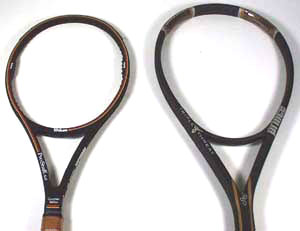
拍面大小:
力量和拍面大小是直接相关的——在相同的条件下,大拍面能比小拍面提供更大的力量。大拍面也能提供更大的击球区域和甜点,从而更多的忽略掉非中心区的击球。当代的拍子涵括了从85到135 平方英寸的拍面尺寸,最通常的在95到110。这个尺寸范围是对多数选手的力量和控制折衷考虑的结果。通常而言,小拍面有利于技巧娴熟的选手谋求更好的控制,而大拍面则对追求更有力和更大的甜点初学者和中级选手颇有吸引力。
此主题相关图片如下:
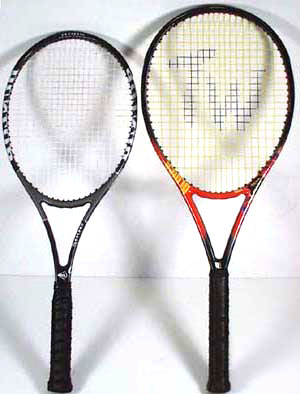
拍长:
通常我们能拿到的拍子,大约在拍长27~29 英寸的范围,这是比赛规定的合法尺度。标准长度是27 英寸。假设其他条件不变,加长的拍子在击落地球时能提供更长的触及范围、增加发球的高度,总体来说能比标准长的拍子略微多提供一些力量。对多数选手而言,从使用标准长的拍子转而使用加长1/2到1 英寸的拍子不会是什么难事。大多数(当然不是全部)加长拍子会比他们对应的标准长版本轻一点以保持操控性能。当拍长增加的时候,动力学挥重随之增加。简单的加长拍子而不减少拍重,会导致产生一根笨拙不实用的棒子。
此主题相关图片如下:
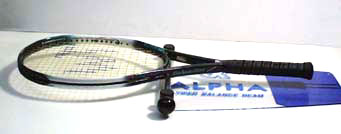
重量和平衡:
当你抓起一支拍子,或者在球场上挥动的时候,有两个最重要的影响因素。先看几个基本概念。
重拍子更有力、更稳定、传递震动较小。而轻拍子更容易操控,因此选手的挥速可以更快。
若果真如此,那么为什么轻拍子不能以他的快挥速来匹敌慢挥速的重拍子,以产生同等的击球力量呢?这个问题在业内被热烈的争论,可以回溯到1990年代Wilson公司引入他们的Hammer 系列球拍。那个时候,球拍的平均重量一般在12~13 盎司,基本上是头轻(也叫“握把重”)的拍子。而Wilson 的Hammer “科技”使得拍子的总重量减少到10~11 盎司,但是在拍头上分配了更多的重量,产生了头重平衡。这个想法是通过保持球拍击球区域重量的方法,来实现不牺牲力量情况下提高操控性。此后,球拍的重量稳中有降,现在各厂商都生产10 盎司重量以下的球拍。
越轻越好吗?其实没必要。
那么,什么样的拍重最适合你?平衡呢?是头轻、头重、还是中点平衡?为了回答这些问题,你需要一点参考。你现在使用的拍子多重?头轻或者头重?数值多少?如果你不知道,你可以e-mail 联系info@tennis-warehouse.com(此为美国网站邮箱,国内顾客请致信动力基因service@dono.com.cn) 。如果现在那支拍子的具体厂商说明还有的话,他们会回信给你。
接下来,你想要一支什么样的拍子呢?轻点、重点、或者重量接近?头轻、头重、还是中点平衡?你或许可以碰运气到偶然遇上一支这样的拍子。如果这不太现实,你可以先知道一些对于不同重量和平衡的长处和缺点。
重且头轻的拍子。
被大多数职业选手所采用,这些球拍通常被认为是“传统的重量和平衡”拍子。典型的是11~13 盎司重,1/2到1-1/2 英寸头轻以保持操控性。多数情况下,我们称之为“选手用拍”,拍子强于控制,为自身发力的选手而设计。
轻且头重的拍子。
若干年前,Wilson 发现不减轻拍头重量而改善拍子的操控性是可能的。通过减少握柄的重量,使得球拍总体质量减轻,同时仍然保留了上部触击球的部分的质量。这就是他们的Hammer 系列和 Sledge Hammer 背后的设计理念。此后,其他几家制造商也引入了轻拍重、头重(以及中点平衡)的球拍。这类拍子的长处是,在不牺牲力量的情况下增加球拍的操控性,尤其在击打落地球的时候。他的缺点相对不是很明确。一些“专家”争论的是减少拍重之后随之增加的震动传递到腕、肘和肩。一些从传统型拍子转而改用新型拍子的选手声称这种球拍感觉不“扎实”。当然,得到一些总要失去一些,这是个取舍问题。不论好坏,减轻球拍重量肯定会改变他的手感。你要记得,如果嫌拍子轻了,给他增加点重量不是什么难事;但是反之,想要减轻拍子的重量,那几乎不可能。
拍框硬度、拍长、重量和平衡
此主题相关图片如下:
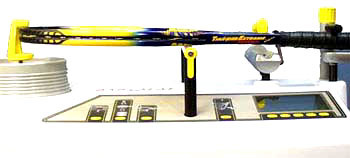
拍框硬度
在触球时间,拍框的偏转程度直接地受球的能量影响。硬的拍子弯曲得比较少,这样消耗掉球上的能量比较少。而柔韧的拍子弯曲会大一些,因此能量的流失也会更多。但是甚至在选手中间,也广为存在一个悖论,也就是说,柔韧的拍子,他弯曲变形得越多,那么他就能回给球更多的能量——就象弹弓一样。事实上,球在线上的停留时间大约是3~5 毫秒,比拍框从变形到恢复的时间要短得多。因此,拍框根本不可能“回”给球能量,他只是吸收球的能量——或多或少,取决于他的硬度。在触击球的时候,因为硬的拍子变形程度不及柔韧的拍子,所以损失的能量也少一些。
拍框硬度的影响不仅仅在于力量方面,对于控制和舒适度也是至关重要的。一般而言,当拍子提供的力量与控制不可兼得。当然这也很大程度上取决于选手个人的类型和能力。高级的选手,可能会更倾向于柔韧的拍子。因为他有足够长且快的挥拍来供给足够的力量。而硬拍子对他们来说,就显得太大力了,随之引起太多的出线。但是对于初学者、或者初中级水平的选手,可能觉得硬的拍子在触球的时候变形不大,这样才有利于控制。而且这种情况,也有可能会出现在挥拍短促有力型的高级选手身上。可以确定的是,通常硬拍子没有柔韧的拍子用起来那么舒服。很硬的拍子,跟中等硬度的拍子比起来,他所传递给腕、肘、肩的冲击更多。当然舒适度是个很难测定的指标——每个选手对感觉得舒服这个定义的理解各不相同。然而可以肯定的是,如果选手的手臂或者肩有问题,选择柔韧或者中等硬度的拍子肯定比选择硬或者非常硬的拍子会有裨益。拍子硬度对球的旋转也有轻微的影响。一般来说,硬的拍子比柔韧的拍子不利于产生旋转,因为球在线上停留的时间相对更短了。
此主题相关图片如下:
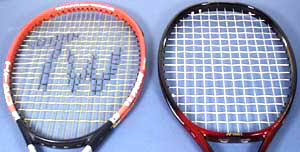
穿线模式
有一点经常被把网球当作娱乐运动的人所忽略的,穿线模式、密度对一支拍子的整体性能表现和感觉的影响有多大。当我们讨论这个话题的时候,我们先把他分为疏的(开放的)和密的(关闭的)。
疏的穿线模式 在受球冲击的时候,线床的变形也就是使球弹回的动力,比密穿线模式的要大。相似的拍子,在同样的穿线磅数下,宽穿线模式的感觉不会象密的感觉上那么紧。而且,疏穿线模式会产生更多的旋转能力,因为在触球时候,由于线床的空间,球能够更深入的嵌入线床。追求旋转球效果的选手能从疏穿线模式中获益。但是你可能为他要付出的一个代价是,降低了线的耐久性。因为这种穿线模式下,线能够相对更自由的移动,因而促使磨损致断线。 密的穿线模式 线床的变形不象疏的那么大,所以回球的反弹力也不那么大。在其他条件相似情况下,密穿线模式比前者减少了赋予球旋转的能力,但是持久性增强了。击球时候不是很在意旋转但是在意增强控制的选手会倾向于这一穿线模式,同时,上旋打法的重炮选手也会选择这个模式来延长线的耐久度。(总不希望在关键一拍时候突然哑火吧,我想。)
握把系统
当拍子越来越轻的时候,所有的制造商都在寻求不显著增加重量的前提下,改善舒适度的方法。近来最常使用的方法是,把减震系统结合到握把中来。比如Dunlop 的 ISIS、Head 的 No SHOX、Prince 的 Air 和 Volkl 的 Sensor 等等设计提供了种种有效的减震方法。Wilson 和 Yonex 做的减震设计是在拍框上的 Iso-Zorb 和 V-Con。
|
|